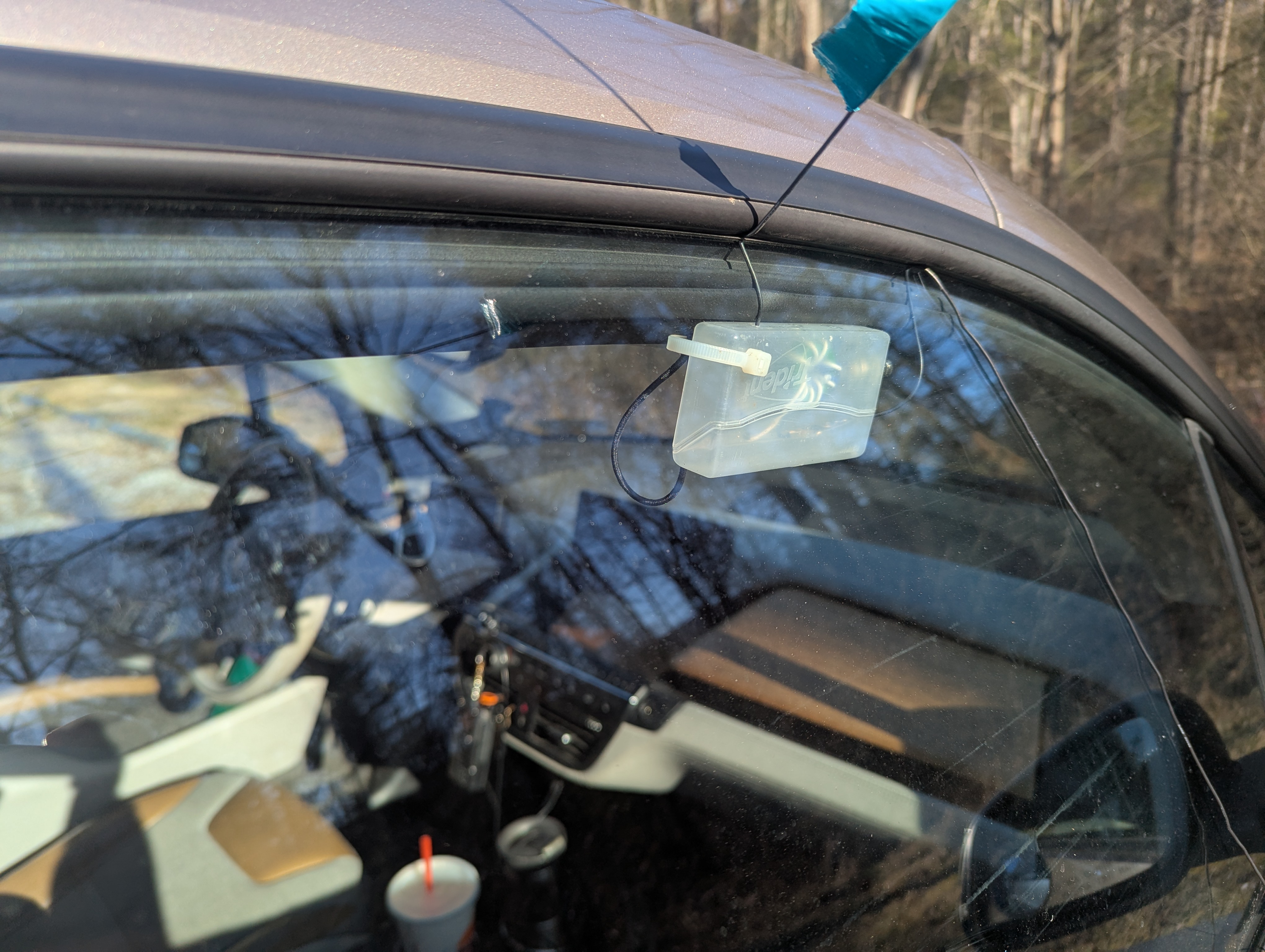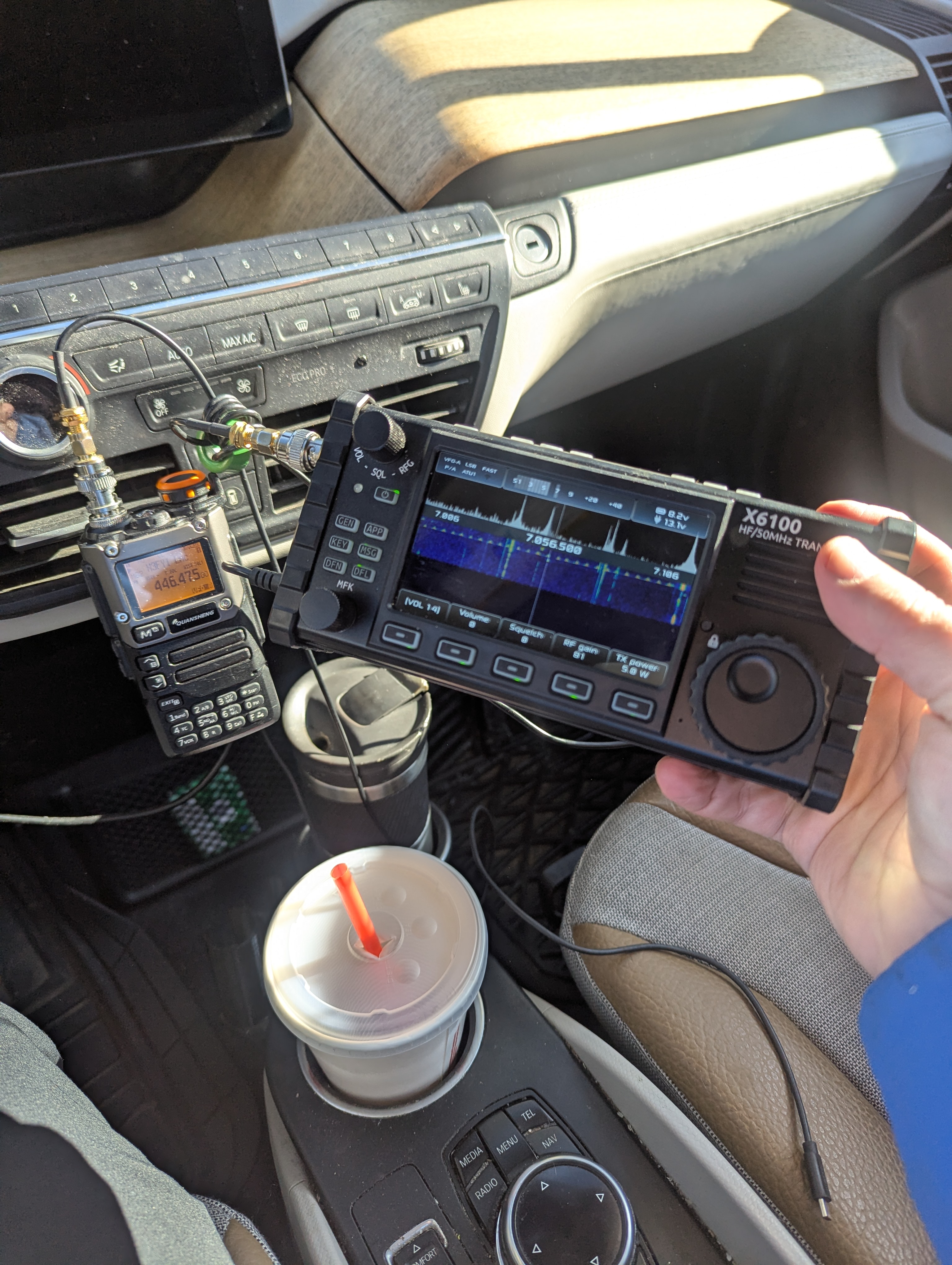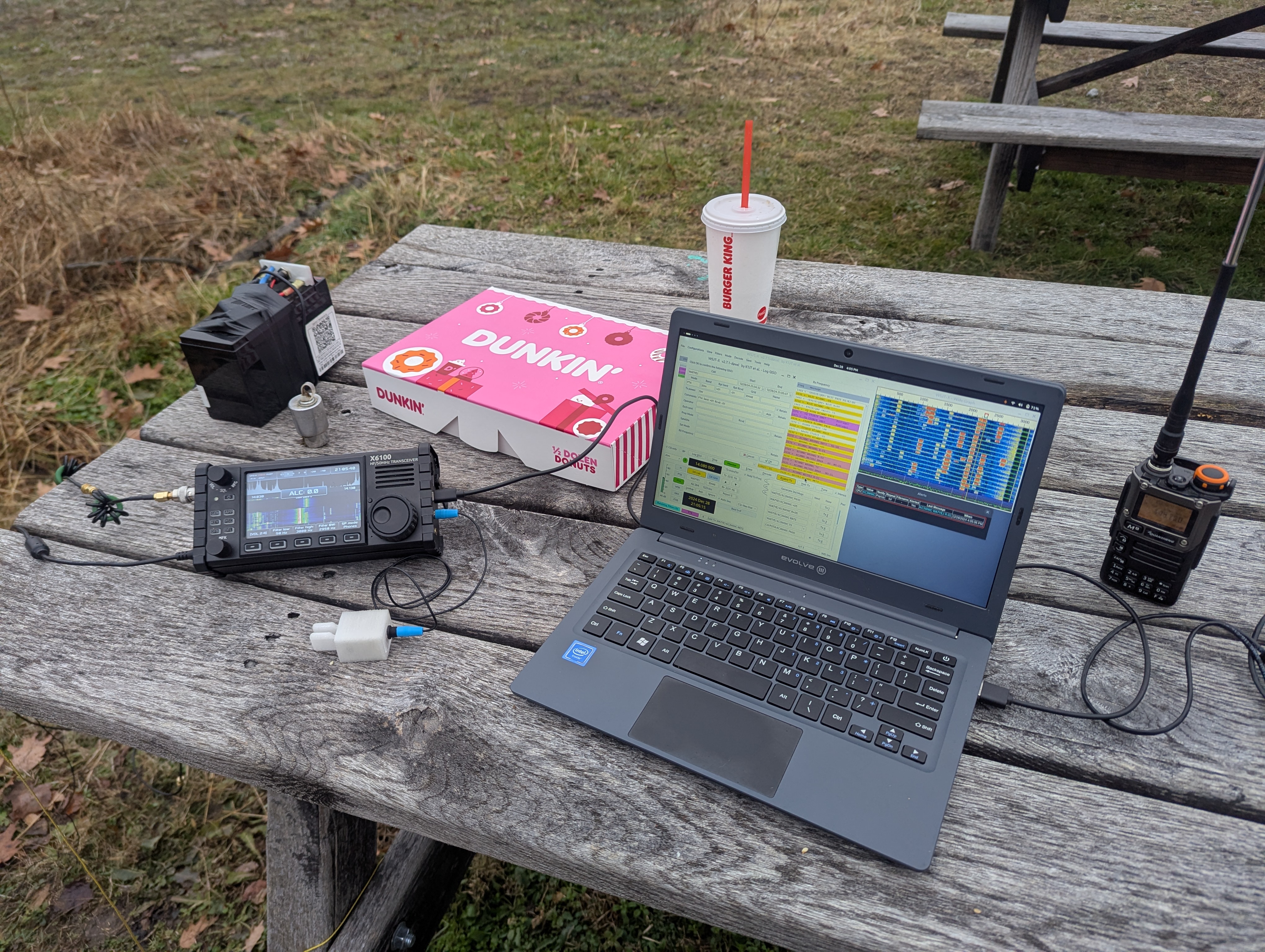I made my first trip to US-1426, Swatara State Park for a quick activation. I stretched the 41-foot EFRW to a tree right from the car window, and made 13 FT8 contacts on 40m.
Diagnose and Repair Bad Coax
I had a bit of bad coax on the most recent POTA, so I set out to test and repair it. I saw no damage to the cable or connectors, but there wasn’t continuity across the middle wire.
Which end is likely bad? I connected each end to the nanovna with a Smith Chart. I found on one end, the smith chart traced a spiral around the outside of the circle. The other side did not react at all, like I hadn’t connected anything. For comparison, I tried another cable I figured was good. That other cable had continuity to each end, and both ends each traced a spiral on the smith chart. The length of the spiral seemed to be related directly to the length of the coax: shorter traced shorter and longer traced longer.
So with that, I replaced the one end that didn’t react, and now the cable looks good.
SWR with the Long Wire
I was using the 71-foot (21.64m) EFRW antenna at home, and I noticed SWR was surprisingly low as measured by the X6100 with the tuner disabled. I suspected loss on the feed line, but I also found this video of another person not using a tuner with the same antenna.
I disconnected my feed line at different places to find SWR jumps way high, so the measurement is working:
- inside window
- outside window
- at the antenna
Does a very long wire have low SWR for everything? Is the 9:1 giving low SWR? The antenna’s working fine, and FT8 shows far-flung signals like always. Disconnecting antenna wire raised SWR above 1.5:1, but not much. Even with wires disconnected from the balun, it’s receiving a very few FT8 signals on 10m, and I can still transmit, but it’s folding back power with SWR just below 2. The tuner is definitely needed for 6m.
985 Workbench: 2024-12-30
My Week in Radio
- ISS on scan, so I caught part of an image
- passes are a bit early right now, and low
- Nice weather
- local POTA including a couple solid CW
- some maintenance of the VHF antennas
- Noticed today I can disable the tuner on my random wire antenna
and still get OK SWR
- sounds like loss to me
- but putting 5W into the wire is still getting identifiable weak signals to Europe, Alaska, etc.
- Reading the AllStar manuals
- Adding 4:1 balun to my list of things to build
- delta loop
- Rybakov vertical
Others
- KC3SCY, Luke:
- crystal receiver
- W8CRW, CR:
- working on a 10m antenna
- W1RC, Mike:
- likes SWR tools, since antennas are the final frontier
- AF3Z, Jim:
- took the Kenwood mobile out of the car to replace the memory battery
- how’s my audio?
- NA3CW, Chuck:
- Jim is low
- arcing in a band switch, so disconnected 10m taps to avoid problems
- added some feed line and changed antennas, so maybe time to try fixing it to do 10 again.
- works now
- finding some bad solder joints in some coax.
- been in repair mode
- KC3OOK, Bill:
- working on Joe’s tower again soon
- WA3VEE, Ron:
- presenting in Pottstown on Friday on antenna analyzers
- May be visiting the field day site
- KC3YIG, Dave:
- picked up Alaska
- W3QP, Tim:
- 2 SOTAs in Western PA
- new Retevis 25W radio
- KV3JGB, Matt:
- fixing some lines to get an antenna up in some trees
- it’s working
- first contact on 10M
- also 15M for a rag chew
- starting CWOps on Friday
- fixing some lines to get an antenna up in some trees
- KB3ZIM, Bob:
- published in latest QST, page 20
- KC3NZT,
- testing coax with NanoVNA
Questions
- KC3SWC, Charles:
- How do 12V batteries apply to Winter Field Day?
li-ion, lead acid, deep cycle lead acid,
AGM, gold cart batteries, lifepo4.
What are the advantages and disadvantages of each.
- WA3VEE, Ron:
- at field day, we won’t be charging any batteries inside
- uses AGM and lifepo4 for radios, no trouble in cold weather
- AGM vents, so ensure it has ventilation
- W3QP, Tim:
- lifepo4 is a good choice for amateur radio
- lighter
- output amperage is usually only 2x capacity
- lifepo4 is a good choice for amateur radio
- W3MFB, Mike:
- used marine cells lots
- WA3VEE, Ron:
- How do 12V batteries apply to Winter Field Day?
li-ion, lead acid, deep cycle lead acid,
AGM, gold cart batteries, lifepo4.
What are the advantages and disadvantages of each.
- W3FES, Fred:
- Troubleshooting a switching power supply.
- Rated for 15 amps.
- Running a radio, 15W output
- Voltage drops to 8V.
- What can he do to diagnose the problem in the power supply?
- WA3VEE, Ron:
- need to look at the manual to see ratings
- NA3CW, Chuck:
- switching power supplies are usually working or dead
21 Tech Net: 2024-12-29
My Week in Radio
- ISS on scan, so caught part of an image
- passes are a bit early right now, and low
- POTA yesterday:
- 2 CW + 28 FT4 contacts on 20m
- pretty rusty on throwing the line into the trees
- bad section of coax
- some antenna maintenance on a nice day
Others
- K3EA, Greg:
- Special event station with local station:
- W2T, Battle of Trenton
- W2P, Battle of Princeton
- Contests
- Canadian Winter Contest
- next weekend
- ARRL kids
- ARRL RTTY Round Up
- NA QSO party
- https://contestcalendar.com/
- Propagation report and DX
- Dominica
- Fiji: 3D2GE, CW only
- watch the DX clusters
- after DXCC award, go for every country on every band.
- Special event station with local station:
- WB3LNY, George
- built a new pc with chirp, and synced up all his HTs
- VE3HOH, Pete
- cleanup, indoors.
- KA3TKW, Tom:
- ISS on night shift: good passes aren’t during the day.
- there’s a packet digipeater
- SSTV is active
- it was only doing telemetry over the weekend
- good passes for SO-50
- https://n2yo.com/
- ham lunch had about 32 people
- thanks Glen for talking about DXCC
- zbitx
- 5 watt QRP SDR TRX
- will be buying one
- shipping in February
- 44 bit ADC
- ISS on night shift: good passes aren’t during the day.
- K3DMM, Denny
- caught SO-51 with a Baofeng 701
- KC3VZU, Bob:
- setup a new TYT 9000D with a slim jim outside
- KK4KKW, Steve:
- new end fed antenna strung into the trees, inverted L, trying it on 10M
- KC3ZBI, Ron:
- new antenna that’s not on the car now,
Swap and Shop
- WB3LNY, George
- dummy loads
- VE3HOH, Pete
- paddles, bugs
- vibroplex
- brown brothers
- oscilliscopes
- a couple Drake TR7s
- tower sections
- a couple Kenwood 130s
- email is good on http://qrz.com/
- paddles, bugs
- KA3TKW, Tom:
- 2 shortwave receivers: RadioShack DX440
- 0-30MHz all mode
- UHF motorola repeaters, 25W
- Yaesu FT1XD, dual band, APRS
- 2 shortwave receivers: RadioShack DX440
- K3MIJ, Troy
- looking for a commercial propane generator
Antenna Maintenance
The 1/4-wave ground plane antenna in the tree dropped its feedline, so I brought it down to reattach it and resolder the radials.
I also walked down the yagi on the pole to straighten some elements, since it was a nice day. The yagi was spinning around in the wind, so I also changed the way it’s mounted to clamp it more securely.
I also added some reigns to the mast, so I can (try to) spin it from inside the window. It works well some times but not others. The pole can freeze to the ground.
POTA US-9719
I activated US-9719 Susquehanna Riverlands. The tempurature was decent, though a little bit of a mist. I got lots of practice throwing very high in the tree. I used all my throw line to hoist my EFHW into the air. Some people lingered to watch while I struggled to get just the right branch.
I found a large section of coax was bad, so had to scramble a little to get enough cable. I worked 20M to get 2 CW park-to-park contacts and 28 more FT4 contacts
985 Workbench: 2024-12-23
My Week in Radio
- Walked down the 35-foot flagpole to do some antenna maintenance in the cold
- Hunting a handful of CW POTA contacts
- Waiting for a good snow day to curl up with the AllStar manual and ARRL antenna book
- Thinking about my path through ham radio and focus on digital modes and CW, not spending much time with SSB
- ISS will be transmitting SSTV on 145.800MHz, 25 December - 5 Januaary
Others
- KC3SCY, Luke:
- On 10m, not so busy this past week
- Working crystal set
- K3FHA, John:
- Fixing up and using an antique radio
- KC3TYX, Vic:
- Diagnosing/repairing a fan problem in a power supply
- NA3CW, Chuck:
- 2M rig in car would shutoff during TX
- PL259 connector was loose
- 2M rig in car would shutoff during TX
- AF3Z, Jim:
- Working 10m
- Working a couple CW contacts: Europe, etc.
- Organizing the shack: radio, photography, etc
- KV3JGB, Matt:
- Fighting with a tree to get an antenna mounted
- KC3SQI, Wayne:
- Talking to Los Angeles then Greenland
- Propagation shifts
- W3DIB, Greg:
- Reverse-engineering the serial protocol of a Yaesu radio
Questions
- W8CRW, CR: From the news, how would one use WSPR to find a downed airplane?
- WA3VEE, Ron: they could be searching for the weak beacon on 121MHz
- KC3SQI, Wayne: May have been looking at WSPR logs to look at reflected signals between stations. reddit
- AF3Z, Jim:
- What is it about WSPR that makes people think they can use it
to search for anomolies?
- KC3WWC, John:
- WSPR is used to test propagation and reach. you send signals for a few minutes, and others report back through a central database without needing to have a conversation or to be even able to get a signal back the other way.
- There’s a huge volume of data that was collected centrally as the plane traveled.
- KC3WWC, John:
- What is it about WSPR that makes people think they can use it
to search for anomolies?
- AF3Z, Jim:
- Recounted his understanding of fuses and how they fail according to voltage rating.
- NA3CW, Chuck: Failure means they can explode.
- KC3SQI, Wayne:
- Father saw huge 4-foot-long industrial fuses explode after lightning strike.
21 Tech Net: 2024-12-22
My Week in Radio
- ARRL 10m contest:
- 13 CW contacts logged on paper
- Iambic keyer set to 20 WPM somewhat confidently
- Still relying on radio to decode for me
- Hunting some CW POTA activators through the week
- Practicing copying CW
- Latest beta of Meshtastic app on Android is reconnecting automatically
- ISS SSTV 25 Dec - 4 Jan
Others
- K3EA, Greg:
- FT8 whack-a-mole
- Saw some RTTY contests
- Canadian contest next weekend
- https://contestcalendar.com/
- Jan 4-5 is RTTY Roundup
- Kids day
- Good space weather, peak of solar cycle
- DX
- Phillipines
- French Guyana
- WB3LNY, George:
- Diagnosing heating connections on large electrical panel
- NE3H, Joe:
- Spoke at length with a bunch of old acquaintances from Taiwan
- KC3VZU, Bob:
- Installing some coax and a 220MHz rig
- KD3AGU, Richard:
- Licensed 3 weeks ago
- Setting up DMR
- Listening to a net in Ephrata
- K3DMM, Denny:
- 16F outside, so no fun standing outside for satellite work
- Tuned some mobile antennas
- Worked a couple ISS passes
- Good SO-50 pass
- Looking forward to lunch on Thursday
- WA3WIJ, Ron:
- Rebuilding Halicrafters radio with caps and tubes
- Preparing for straight key night
- KC3ZBI, Ron:
- Working on an outside antenna
- Trying for 12 days of Christmas Event
- N7JMS, Jon:
- Got some new countries on FT8/FT4
- Building a 10M loop antenna
- Is there any C4FM or Fusion available in the Harrisburg area?
- K3DMM, Denny: 447.925
NVIS
I watched a video about NVIS NVIS achieves 75-90 degree take-off, very vertical, and about a 400-mile range. It can get you over obstacles. It’s most effective on 40m and 80m.
To build it, mount a dipole 1/8 wavelength above ground, horizontal. Add a reflector almost on the ground, 5% longer, to keep the ground from absorbing the signal.




